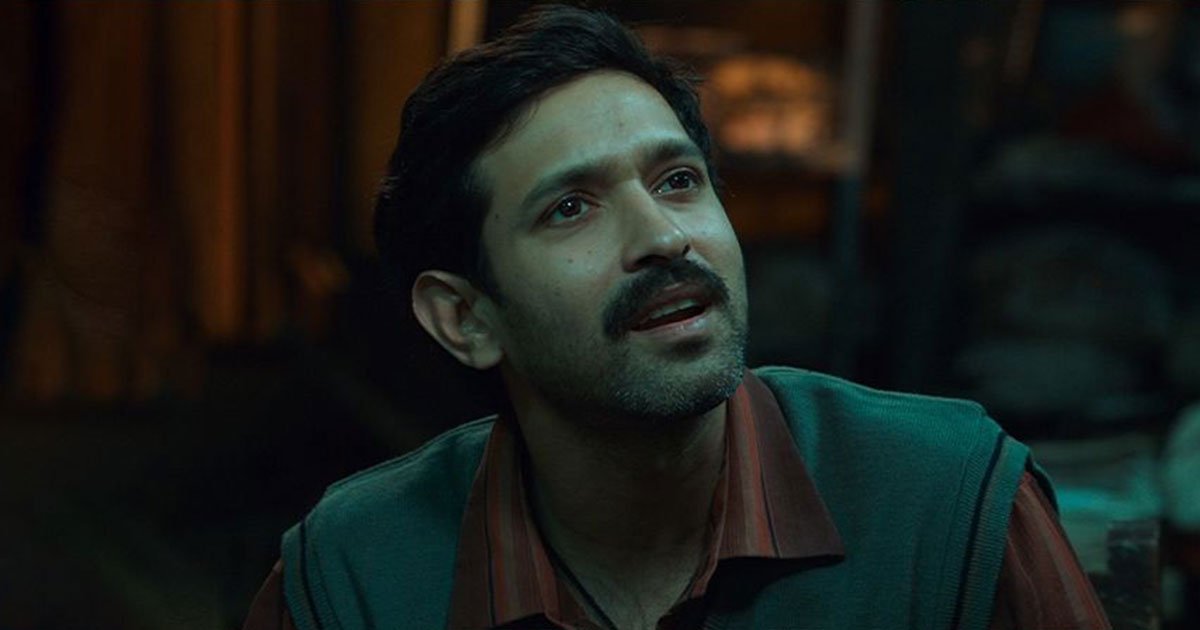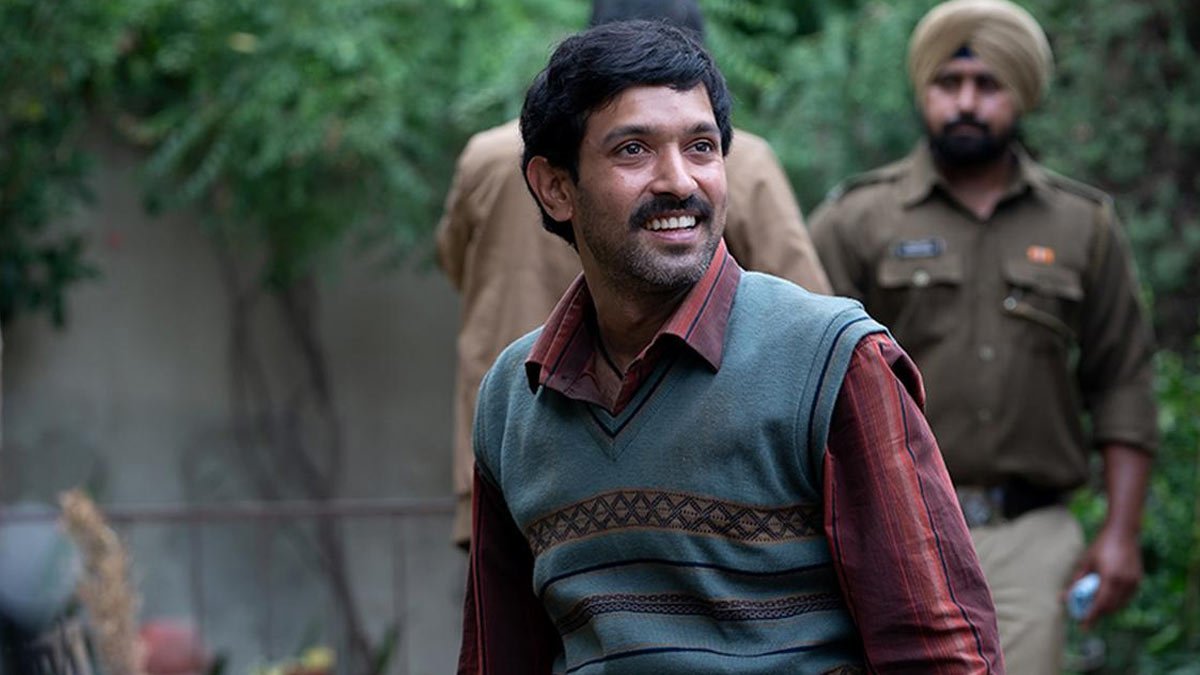Trigger Warning: gore, child sexual abuse
Sector 36 was released on Netflix earlier this month and has become a reason for discussion. The film opens with Vikrant Massey watching Sab Banenge Crorepati wrapped in a velvet gown and speaking with his wife on the phone. A photo of him and his wife and daughter is staged upright on a corner table. The moment of luxury coupled with desire is supplied with the visual of a plate full of meat and bones.
The film opens with Vikrant Massey watching Sab Banenge Crorepati wrapped in a velvet gown and speaking with his wife on the phone
The next shot takes us to his servant quarter where the façade of the regal gown drops to the reality of a damp and rotten room with a toilet that stinks through the screen. The camera then draws into the face of the victim, a minor girl still wearing her school uniform. From there to the leg, he is about to see the blood flowing down the toilet on which she is seated.
Vikrant Massey conveys the entire story that needed to be told in just these initial few moments, the rest of the film seems gasping to match his calibre.
Sector 36 draws inspiration from the infamous Nithari Kand. The film becomes even more relevant when the culprits are out of jail. A story that involves murder, abuse, domination, manipulation, necrophilia, and cannibalism is told with empathy. The character of the servant is given time to form and breathe. He owns the screen and his desperation for new flesh vulgarly peeps through, literally and metaphorically.
The class difference in Sector 36
The crime is committed in a bungalow that belongs to a businessman settled in Karnal. He is an eminent person of the community and has important relations. The drains along his home are clogged with dead bodies and scattered body parts. The parts are discovered by children playing on the other side of the road and when the police arrive, they state the hand to be a monkey’s claw and reward the child with a currency note.
The child ends up being the next victim in Sector 36 and is dumped in the same drain. But before the act, Vikrant takes his time to deliver a monologue stating the future of Ali. Poor boys like him are easily replaced with another kid and life goes on without anyone missing their presence. While vicious, what he says is true indeed.
The crimes of Sector 36 keep happening under the police radar specifically in the poorer end of the neighbourhood. Hundreds of children go missing and posters on the police display board keep piling up. While the police follow the system and ignore the poor, the stark class difference becomes apparent by the kidnapping of a rich kid. The kid is discovered in a couple of days and kidnappers meet their fate, while hundreds of families in the dungeons wait endlessly for justice.
The gender gap in Sector 36
The culprits attack both genders. The children are kidnapped and slowly killed. The abuse that is hinted at is never shown. There is no evidence of it happening but there are some undercurrents or suggestions of it.
When Balbir Singh Bassi (Akash Khurana) returns from Karnal, he asks Prem Singh (Vikrant Massey) to keep the girl ready. Minor girls are invited and paid for sex. It is the disappearance of such a girl that accelerates the arrest of Bassi and Prem Singh in Sector 36. The case intrigues Inspector Ram (Deepak Dobriyal) and also challenges his perception of the world as he witnesses a father pimping his own daughter.
Women are not respected, neither are men. The respect is reserved for the hierarchy and only the wealthy command respect. Women characters in Sector 36 are mostly passive and ornamental. From wives to victims, their stories are not told and they lack agency. While Bassi’s family is a passive audience, Prem Singh’s wife is clueless of his acts.
The Freudian crime
Prem Singh’s life, his plight, and his madness are beautifully depicted. Only Massey could have supplied this character with so much authenticity that at some points the audience ends up feeling sorry for him. The crime and its rawness almost make us question the system more than the criminal.
He is sloppy, he is repetitive and is still away from the clutches of the police. But he has a story, a childhood trauma that explains his character. His repressed feelings surface when he is pushed to the brink of a breakdown. The confession is chilling and the passion with which it is recited runs a chill back the spine.
The need of Prem Singh to protect Bassi and call him father depicts how he is also a victim.
The need of Prem Singh to protect Bassi and call him father depicts how he is also a victim. His vulnerabilities have been exploited and his passion is fed with poison. His whims are satisfied with perverse offerings and easily gives in to the pleasure. In a country that seldom talks about mental health, Prem Singh from Sector 36 should be a character read and discussed.
Sector 36 keeps the audience glued to the screen throughout its run time. At moments, it weakens but at other junctures the pace picks up and some intensity is brought back. From a story of crime, it soon becomes a story of a policeman’s redemption. Inspector Ram travels and puts himself in danger to unearth the evidence that implies that the syndicate is bigger than it appears.
There is an implicit story behind the story where police, businessmen, and politicians work together to hide the crime and destroy the evidence. This angle is only hinted at but never developed. Sector 36 seems to be the saga of Prem Singh. He sucks in all the air while Ram claims his fame.
Bassi’s involvement is never exposed, and neither is the evidence unmasked. It is a case that has happened and we all know the nitty gritty through the media cameras. The film fails to provide any more information to the audience. It keeps re-asserting while trying to cover something and justify something else in its wake.
Sector 36 hits hard but fails to question. The gore and grotesque is real, almost too real.
Sector 36 hits hard but fails to question. The gore and grotesque is real, almost too real. The need for sex and the revenge of insults that hurt the ego is conveyed beautifully but no victim’s character is built or the families’ plight heard. Sector 36 should be watched and discussed but it does not leave an impression. The film stumbles in the middle and loses the plot at some junctures. The ending is a valid social commentary but it leaves more unanswered questions than answers.
Films like Sector 36 need to be told but the makers must discuss both sides. It feels like the grotesque is made more brutal to cover the weak storyline and gloss over the tired dialogues. It is yet another failed attempt at garnering empathy for the culprit. A film that could have shown the victims and the importance of their lives ends up burying them further.
The truths are still veiled behind the walls of that house that has seen so much horror. Sector 36 is a sad attempt at discussing an essential social issue, it is almost there but not quite. It is more visual than actual interpretation of the events. It is a brave attempt but stops being anything more than an attempt.
About the author(s)
Dr. Guni Vats is an Assistant Professor at the Department of English, Manav Rachna International Institute of Research and Studies. A PhD in Gender Studies, she is a renowned researcher, writer, and scholar.










